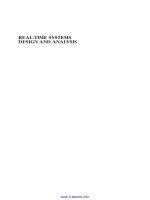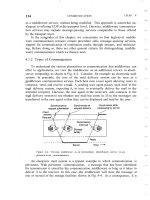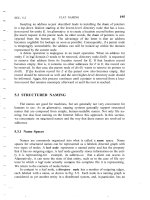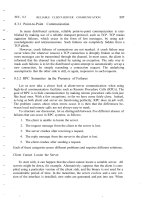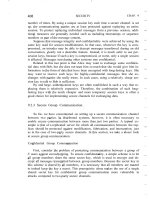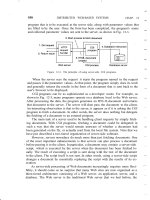Operating Systems Design and Implementation, Third Edition phần 1 doc
Bạn đang xem bản rút gọn của tài liệu. Xem và tải ngay bản đầy đủ của tài liệu tại đây (1.7 MB, 93 trang )
•
Table of
Contents
&"87%" class="v1"
height="17">Index
Operating Systems Design and Implementation, Third Edition
By Andrew S. Tanenbaum - Vrije Universiteit Amsterdam, The
Netherlands, Albert S. Woodhull - Amherst, Massachusetts
Publisher: Prentice Hall
Pub Date: January 04, 2006
Print
ISBN-10
: 0-13-142938-8
Print
ISBN-13
: 978-0-13-142938-3
eText
ISBN-10
: 0-13-185991-9
eText
ISBN-13
: 978-0-13-185991-3
Pages: 1080
Revised to address the latest version of MINIX (MINIX 3), this
streamlined, simplified new edition remains the only operating systems
text to first explain relevant principles, then demonstrate their
applications using a Unix-like operating system as a detailed example. It
has been especially designed for high reliability, for use in embedded
systems, and for ease of teaching.
For the latest version of MINIX and simulators for running MINIX on
other systems visit: www.minix3.org
1
1
Simpo PDF Merge and Split Unregistered Version -
2
2
Simpo PDF Merge and Split Unregistered Version -
•
Table of
Contents
&"87%" class="v1"
height="17">Index
Operating Systems Design and Implementation, Third Edition
By Andrew S. Tanenbaum - Vrije Universiteit Amsterdam, The
Netherlands, Albert S. Woodhull - Amherst, Massachusetts
Publisher: Prentice Hall
Pub Date: January 04, 2006
ISBN-10
: 0-13-142938-8
ISBN-13
: 978-0-13-142938-3
eText
ISBN-10
: 0-13-185991-9
eText
ISBN-13
: 978-0-13-185991-3
Pages: 1080
Copyright
Preface
Chapter
1.
Introduction
Section
1.1.
What
Is
an
Operating
System?
Section
1.2.
History
of
Operating
Systems
Section
1.3.
Operating
System
Concepts
Section
1.4.
System
Calls
Section
1.5.
Operating
System
Structure
Section
1.6.
Outline
1
1
Simpo PDF Merge and Split Unregistered Version -
of
the
Rest
of
This
Book
Section
1.7.
Summary
Problems
Chapter
2.
Processes
Section
2.1.
Introduction
to
Processes
Section
2.2.
Interprocess
Communication
Section
2.3.
Classical
IPC
Problems
Section
2.4.
Scheduling
Section
2.5.
Overview
of
Processes
in
MINIX
3
Section
2.6.
Implementation
of
Processes
in
MINIX
3
Section
2.7.
The
System
Task
in
MINIX
3
2
2
Simpo PDF Merge and Split Unregistered Version -
Section
2.8.
The
Clock
Task
in
MINIX
3
Section
2.9.
Summary
Problems
Chapter
3.
Input/Output
Section
3.1.
Principles
of
I/O
Hardware
Section
3.2.
Principles
of
I/O
Software
Section
3.3.
Deadlocks
Section
3.4.
Overview
of
I/O
in
MINIX
3
Section
3.5.
Block
Devices
in
MINIX
3
Section
3.6.
RAM
Disks
Section
3.7.
Disks
Section
3.8.
3
3
Simpo PDF Merge and Split Unregistered Version -
Terminals
Section
3.9.
Summary
Problems
Chapter
4.
Memory
Management
Section
4.1.
Basic
Memory
Management
Section
4.2.
Swapping
Section
4.3.
Virtual
Memory
Section
4.4.
Page
Replacement
Algorithms
Section
4.5.
Design
Issues
for
Paging
Systems
Section
4.6.
Segmentation
Section
4.7.
Overview
of
the
MINIX
3
Process
Manager
Section
4.8.
Implementation
of
the
MINIX
3
Process
Manager
4
4
Simpo PDF Merge and Split Unregistered Version -
Section
4.9.
Summary
Problems
Chapter
5.
File
Systems
Section
5.1.
Files
Section
5.2.
Directories
Section
5.3.
File
System
Implementation
Section
5.4.
Security
Section
5.5.
Protection
Mechanisms
Section
5.6.
Overview
of
the
MINIX
3
File
System
Section
5.7.
Implementation
of
the
MINIX
3
File
System
Section
5.8.
Summary
Problems
Chapter
6.
Reading
List
and
Bibliography
5
5
Simpo PDF Merge and Split Unregistered Version -
Section
6.1.
Suggestions
for
Further
Reading
Section
6.2.
Alphabetical
Bibliography
Appendix
A.
Installing
MINIX
3
Section
A.1.
Preparation
Section
A.2.
Booting
Section
A.3.
Installing
to
the
Hard
Disk
Section
A.4.
Testing
Section
A.5.
Using
a
Simulator
Appendix
B.
The
MINIX
Source
Code
Appendix
C.
Index
to
Files
About
the
Authors
About
the
MINIX
3
6
6
Simpo PDF Merge and Split Unregistered Version -
CD
System
Requirements
Hardware
Software
Installation
Product
Support
Index
7
7
Simpo PDF Merge and Split Unregistered Version -
8
8
Simpo PDF Merge and Split Unregistered Version -
Copyright
[Page iv]
Library of Congress Cataloging in Publication Data
Tanenbaum, Andrew S.
Operating Systems: Design and Implementation / Andrew S. Tanenbaum, Albert S. Woodhull. 3rd ed.
ISBN: 0-13-142938-8
1. Operating systems (Computers) I. Woodhull, Albert S. II. Title
QA76.76.O63T36 2006
005.4'3 dc22
Vice President and Editorial Director, ECS: Marcia J. Horton
Executive Editor: Tracy Dunkelberger
Editorial Assistant: Christianna Lee
Executive Managing Editor: Vince O'Brien
Managing Editor: Camille Trentacoste
Director of Creative Services: Paul Belfanti
Art Director and Cover Manager: Heather Scott
Cover Design and Illutsration: Tamara Newnam
Managing Editor, AV Management and Production: Patricia Burns
Art Editor: Gregory Dulles
Manufacturing Manager, ESM: Alexis Heydt-Long
Manufacturing Buyer: Lisa McDowell
Executive Marketing Manager: Robin O'Brien
Marketing Assistant: Barrie Reinhold
© 2006, 1997, 1987 by Pearson Education, Inc.
Pearson Prentice Hall
Pearson Education, Inc.
Upper Saddle River, NJ 07458
All rights reserved. No part of this book may be reproduced in any form or by any means, without permission
in writing from the publisher.
1
1
Simpo PDF Merge and Split Unregistered Version -
Pearson Prentice Hall® is a trademark of Pearson Education, Inc.
The authors and publisher of this book have used their best efforts in preparing this book. These efforts
include the development, research, and testing of the theories and programs to determine their effectiveness.
The authors and publisher make no warranty of any kind, expressed or implied, with regard to these programs
or to the documentation contained in this book. The authors and publisher shall not be liable in any event for
incidental or consequential damages in connection with, or arising out of, the furnishing, performance, or use
of these programs.
All rights reserved. No part of this book may be reproduced, in any form or by any means, without permission
in writing from the publisher.
Printed in the United States of America
10 9 8 7 6 5 4 3 2 1
Pearson Education Ltd., London
Pearson Education Australia Pty. Ltd., Sydney
Pearson Education Singapore, Pte. Ltd.
Pearson Education North Asia Ltd., Hong Kong
Pearson Education Canada, Inc., Toronto
Pearson Educación de Mexico, S.A. de C.V.
Pearson Education-Japan, Tokyo
Pearson Education Malaysia, Pte. Ltd.
Pearson Education, Inc., Upper Saddle River, New Jersey
Dedication
To Suzanne, Barbara, Marvin, and the memory of Sweetie π and Bram
AST
To Barbara and Gordon
ASW
The MINIX 3 Mascot
Other operating systems have an animal mascot, so we felt MINIX 3 ought to have one too. We chose the
raccoon because raccoons are small, cute, clever, agile, eat bugs, and are user-friendlyat least if you keep your
garbage can well locked.
2
2
Simpo PDF Merge and Split Unregistered Version -
[Page xv]
Preface
Most books on operating systems are strong on theory and weak on practice. This one aims to provide a better
balance between the two. It covers all the fundamental principles in great detail, including processes,
interprocess communication, semaphores, monitors, message passing, scheduling algorithms, input/output,
deadlocks, device drivers, memory management, paging algorithms, file system design, security, and
protection mechanisms. But it also discusses one particular systemMINIX 3a UNIX-compatible operating
system in detail, and even provides a source code listing for study. This arrangement allows the reader not
only to learn the principles, but also to see how they are applied in a real operating system.
When the first edition of this book appeared in 1987, it caused something of a small revolution in the way
operating systems courses were taught. Until then, most courses just covered theory. With the appearance of
MINIX, many schools began to have laboratory courses in which students examined a real operating system
to see how it worked inside. We consider this trend highly desirable and hope it continues.
It its first 10 years, MINIX underwent many changes. The original code was designed for a 256K 8088-based
IBM PC with two diskette drives and no hard disk. It was also based on UNIX Version 7 As time went on,
MINIX evolved in many ways: it supported 32-bit protected mode machines with large memories and hard
disks. It also changed from being based on Version 7, to being based on the international POSIX standard
(IEEE 1003.1 and ISO 9945-1). Finally, many new features were added, perhaps too many in our view, but
too few in the view of some other people, which led to the creation of Linux. In addition, MINIX was ported
to many other platforms, including the Macintosh, Amiga, Atari, and SPARC. A second edition of the book,
covering this system, was published in 1997 and was widely used at universities.
[Page xvi]
The popularity of MINIX has continued, as can be observed by examining the number of hits for MINIX
found by Google.
This third edition of the book has many changes throughout. Nearly all of the material on principles has been
revised, and considerable new material has been added. However, the main change is the discussion of the
new version of the system, called MINIX 3. and the inclusion of the new code in this book. Although loosely
based on MINIX 2, MINIX 3 is fundamentally different in many key ways.
The design of MINIX 3 was inspired by the observation that operating systems are becoming bloated, slow,
and unreliable. They crash far more often than other electronic devices such as televisions, cell phones, and
DVD players and have so many features and options that practically nobody can understand them fully or
manage them well. And of course, computer viruses, worms, spyware, spam, and other forms of malware have
become epidemic.
To a large extent, many of these problems are caused by a fundamental design flaw in current operating
systems: their lack of modularity. The entire operatng system is typically millions of lines of C/C++ code
compiled into a single massive executable program run in kernel mode. A bug in any one of those millions of
lines of code can cause the system to malfunction. Getting all this code correct is impossible, especially when
about 70% consists of device drivers, written by third parties, and outside the purview of the people
maintaining the operating system.
With MINIX 3, we demonstrate that this monolithic design is not the only possibility. The MINIX 3 kernel is
only about 4000 lines of executable code, not the millions found in Windows, Linux, Mac OSX, or FreeBSD.
1
1
Simpo PDF Merge and Split Unregistered Version -
The rest of the system, including all the device drivers (except the clock driver), is a collection of small,
modular, user-mode processes, each of which is tightly restricted in what it can do and with which other
processes it may communicate.
While MINIX 3 is a work in progress, we believe that this model of building an operating system as a
collection of highly-encapsulated user-mode processes holds promise for building more reliable systems in the
future. MINIX 3 is especially focused on smaller PCs (such as those commonly found in Third-World
countries and on embedded systems, which are always resource constrained). In any event, this design makes
it much easier for students to learn how an operating system works than attempting to study a huge monolithic
system.
The CD-ROM that is included in this book is a live CD. You can put it in your CD-ROM drive, reboot the
computer, and MINIX 3 will give a login prompt within a few seconds. You can log in as root and give the
system a try without first having to install it on your hard disk. Of course, it can also be installed on the hard
disk. Detailed installation instructions are given in Appendix A.
[Page xvii]
As suggested above, MINIX 3 is rapidly evolving, with new versions being issued frequently. To download
the current CD-ROM image file for burning, please go to the official Website: www.minix3.org. This site also
contains a large amount of new software, documentation, and news about MINIX 3 development. For
discussions about MINIX 3, or to ask questions, there is a USENET newsgroup: comp.os.minix. People
without newsreaders can follow discussions on the Web at />As an alternative to installing MINIX 3 on your hard disk, it is possible to run it on any one of several PC
simulators now available. Some of these are listed on the main page of the Website.
Instructors who are using the book as the text for a university course can get the problem solutions from their
local Prentice Hall representative. The book has its own Website. It can be found by going to
www.prenhall.com/tanenbaum and selecting this title.
We have been extremely fortunate in having the help of many people during the course of this project. First
and foremost, Ben Gras and Jorrit Herder have done most of the programming of the new version. They did a
great job under tight time constraints, including responding to e-mail well after midnight on many occasions.
They also read the manuscript and made many useful comments. Our deepest appreciation to both of them.
Kees Bot also helped greatly with previous versions, giving us a good base to work with. Kees wrote large
chunks of code for versions up to 2.0.4, repaired bugs, and answered numerous questions. Philip Homburg
wrote most of the networking code as well as helping out in numerous other useful ways, especially providing
detailed feedback on the manuscript.
People too numerous to list contributed code to the very early versions, helping to get MINIX off the ground
in the first place. There were so many of them and their contributions have been so varied that we cannot even
begin to list them all here, so the best we can do is a generic thank you to all of them.
Several people read parts of the manuscript and made suggestions. We would like to give our special thanks to
Gojko Babic, Michael Crowley, Joseph M. Kizza, Sam Kohn Alexander Manov, and Du Zhang for their help.
Finally, we would like to thank our families. Suzanne has been through this 16 times now. Barbara has been
through it 15 times now. Marvin has been through it 14 times now. It's kind of getting to be routine, but the
love and support is still much appreciated. (AST)
Al's Barbara has been through this twice now. Her support, patience, and good humor were essential. Gordon
2
2
Simpo PDF Merge and Split Unregistered Version -
has been a patient listener. It is still a delight to have a son who understands and cares about the things that
fascinate me. Finally, step-grandson Zain's first birthday coincides with the release of MINIX 3. Some day he
will appreciate this. (ASW)
Andrew S. Tanenbaum
Albert S. Woodhull
3
3
Simpo PDF Merge and Split Unregistered Version -
4
4
Simpo PDF Merge and Split Unregistered Version -
[Page 1]
1. Introduction
Without its software, a computer is basically a useless lump of metal. With its software, a computer can store,
process, and retrieve information; play music and videos; send e-mail, search the Internet; and engage in many
other valuable activities to earn its keep. Computer software can be divided roughly into two kinds: system
programs, which manage the operation of the computer itself, and application programs, which perform the
actual work the user wants. The most fundamental system program is the operating system, whose job is to
control all the computer's resources and provide a base upon which the application programs can be written.
Operating systems are the topic of this book. In particular, an operating system called MINIX 3 is used as a
model, to illustrate design principles and the realities of implementing a design.
A modern computer system consists of one or more processors, some main memory, disks, printers, a
keyboard, a display, network interfaces, and other input/output devices. All in all, a complex system. Writing
programs that keep track of all these components and use them correctly, let alone optimally, is an extremely
difficult job. If every programmer had to be concerned with how disk drives work, and with all the dozens of
things that could go wrong when reading a disk block, it is unlikely that many programs could be written at
all.
Many years ago it became abundantly clear that some way had to be found to shield programmers from the
complexity of the hardware. The way that has evolved gradually is to put a layer of software on top of the bare
hardware, to manage all parts of the system, and present the user with an interface or virtual machine that is
easier to understand and program. This layer of software is the operating system.
[Page 2]
The placement of the operating system is shown in Fig. 1-1. At the bottom is the hardware, which, in many
cases, is itself composed of two or more levels (or layers). The lowest level contains physical devices,
consisting of integrated circuit chips, wires, power supplies, cathode ray tubes, and similar physical devices.
How these are constructed and how they work is the province of the electrical engineer.
Figure 1-1. A computer system consists of hardware, system programs, and application programs.
1
1
Simpo PDF Merge and Split Unregistered Version -
Next comes the microarchitecture level, in which the physical devices are grouped together to form functional
units. Typically this level contains some registers internal to the CPU (Central Processing Unit) and a data
path containing an arithmetic logic unit. In each clock cycle, one or two operands are fetched from the
registers and combined in the arithmetic logic unit (for example, by addition or Boolean AND). The result is
stored in one or more registers. On some machines, the operation of the data path is controlled by software,
called the microprogram. On other machines, it is controlled directly by hardware circuits.
The purpose of the data path is to execute some set of instructions. Some of these can be carried out in one
data path cycle; others may require multiple data path cycles. These instructions may use registers or other
hardware facilities. Together, the hardware and instructions visible to an assembly language programmer form
the ISA (Instruction Set Architecture) This level is often called machine language.
The machine language typically has between 50 and 300 instructions, mostly for moving data around the
machine, doing arithmetic, and comparing values. In this level, the input/output devices are controlled by
loading values into special device registers. For example, a disk can be commanded to read by loading the
values of the disk address, main memory address, byte count, and direction (read or write) into its registers. In
practice, many more parameters are needed, and the status returned by the drive after an operation may be
complex. Furthermore, for many I/O (Input/Output) devices, timing plays an important role in the
programming.
[Page 3]
A major function of the operating system is to hide all this complexity and give the programmer a more
convenient set of instructions to work with. For example, read block from file is conceptually much
simpler than having to worry about the details of moving disk heads, waiting for them to settle down, and so
on.
On top of the operating system is the rest of the system software. Here we find the command interpreter
(shell), window systems, compilers, editors, and similar application-independent programs. It is important to
realize that these programs are definitely not part of the operating system, even though they are typically
supplied preinstalled by the computer manufacturer, or in a package with the operating system if it is installed
after purchase. This is a crucial, but subtle, point. The operating system is (usually) that portion of the
software that runs in kernel mode or supervisor mode. It is protected from user tampering by the hardware
(ignoring for the moment some older or low-end microprocessors that do not have hardware protection at all).
Compilers and editors run in user mode. If a user does not like a particular compiler, he
[ ]
is free to write his
own if he so chooses; he is not free to write his own clock interrupt handler, which is part of the operating
system and is normally protected by hardware against attempts by users to modify it.
[ ]
"He" should be read as "he or she" throughout the book.
This distinction, however, is sometimes blurred in embedded systems (which may not have kernel mode) or
interpreted systems (such as Java-based systems that use interpretation, not hardware, to separate the
components). Still, for traditional computers, the operating system is what runs in kernel mode.
That said, in many systems there are programs that run in user mode but which help the operating system or
perform privileged functions. For example, there is often a program that allows users to change their
passwords. This program is not part of the operating system and does not run in kernel mode, but it clearly
carries out a sensitive function and has to be protected in a special way.
In some systems, including MINIX 3, this idea is carried to an extreme form, and pieces of what is
traditionally considered to be the operating system (such as the file system) run in user space. In such systems,
it is difficult to draw a clear boundary. Everything running in kernel mode is clearly part of the operating
system, but some programs running outside it are arguably also part of it, or at least closely associated with it.
2
2
Simpo PDF Merge and Split Unregistered Version -
For example, in MINIX 3, the file system is simply a big C program running in user-mode.
Finally, above the system programs come the application programs. These programs are purchased (or written
by) the users to solve their particular problems, such as word processing, spreadsheets, engineering
calculations, or storing information in a database.
3
3
Simpo PDF Merge and Split Unregistered Version -
4
4
Simpo PDF Merge and Split Unregistered Version -
[Page 4]
1.1. What Is an Operating System?
Most computer users have had some experience with an operating system, but it is difficult to pin down
precisely what an operating system is. Part of the problem is that operating systems perform two basically
unrelated functions, extending the machine and managing resources, and depending on who is doing the
talking, you hear mostly about one function or the other. Let us now look at both.
1.1.1. The Operating System as an Extended Machine
As mentioned earlier, the architecture (instruction set, memory organization, I/O, and bus structure) of most
computers at the machine language level is primitive and awkward to program, especially for input/output. To
make this point more concrete, let us briefly look at how floppy disk I/O is done using the NEC PD765
compatible controller chips used on many Intel-based personal computers. (Throughout this book we will use
the terms "floppy disk" and "diskette" interchangeably.) The PD765 has 16 commands, each specified by
loading between 1 and 9 bytes into a device register. These commands are for reading and writing data,
moving the disk arm, and formatting tracks, as well as initializing, sensing, resetting, and recalibrating the
controller and the drives.
The most basic commands are read and write, each of which requires 13 parameters, packed into 9 bytes.
These parameters specify such items as the address of the disk block to be read, the number of sectors per
track, the recording mode used on the physical medium, the intersector gap spacing, and what to do with a
deleted-data-address-mark. If you do not understand this mumbo jumbo, do not worry; that is precisely the
pointit is rather esoteric. When the operation is completed, the controller chip returns 23 status and error fields
packed into 7 bytes. As if this were not enough, the floppy disk programmer must also be constantly aware of
whether the motor is on or off. If the motor is off, it must be turned on (with a long startup delay) before data
can be read or written. The motor cannot be left on too long, however, or the floppy disk will wear out. The
programmer is thus forced to deal with the trade-off between long startup delays versus wearing out floppy
disks (and losing the data on them).
Without going into the real details, it should be clear that the average programmer probably does not want to
get too intimately involved with the programming of floppy disks (or hard disks, which are just as complex
and quite different). Instead, what the programmer wants is a simple, high-level abstraction to deal with. In
the case of disks, a typical abstraction would be that the disk contains a collection of named files. Each file
can be opened for reading or writing, then read or written, and finally closed. Details such as whether or not
recording should use modified frequency modulation and what the current state of the motor is should not
appear in the abstraction presented to the user.
[Page 5]
The program that hides the truth about the hardware from the programmer and presents a nice, simple view of
named files that can be read and written is, of course, the operating system. Just as the operating system
shields the programmer from the disk hardware and presents a simple file-oriented interface, it also conceals a
lot of unpleasant business concerning interrupts, timers, memory management, and other low-level features.
In each case, the abstraction offered by the operating system is simpler and easier to use than that offered by
the underlying hardware.
In this view, the function of the operating system is to present the user with the equivalent of an extended
machine or virtual machine that is easier to program than the underlying hardware. How the operating system
1
1
Simpo PDF Merge and Split Unregistered Version -
achieves this goal is a long story, which we will study in detail throughout this book. To summarize it in a
nutshell, the operating system provides a variety of services that programs can obtain using special
instructions called system calls. We will examine some of the more common system calls later in this chapter.
1.1.2. The Operating System as a Resource Manager
The concept of the operating system as primarily providing its users with a convenient interface is a top-down
view. An alternative, bottom-up, view holds that the operating system is there to manage all the pieces of a
complex system. Modern computers consist of processors, memories, timers, disks, mice, network interfaces,
printers, and a wide variety of other devices. In the alternative view, the job of the operating system is to
provide for an orderly and controlled allocation of the processors, memories, and I/O devices among the
various programs competing for them.
Imagine what would happen if three programs running on some computer all tried to print their output
simultaneously on the same printer. The first few lines of printout might be from program 1, the next few
from program 2, then some from program 3, and so forth. The result would be chaos. The operating system
can bring order to the potential chaos by buffering all the output destined for the printer on the disk. When one
program is finished, the operating system can then copy its output from the disk file where it has been stored
to the printer, while at the same time the other program can continue generating more output, oblivious to the
fact that the output is not really going to the printer (yet).
When a computer (or network) has multiple users, the need for managing and protecting the memory, I/O
devices, and other resources is even greater, since the users might otherwise interfere with one another. In
addition, users often need to share not only hardware, but information (files, databases, etc.) as well. In short,
this view of the operating system holds that its primary task is to keep track of who is using which resource, to
grant resource requests, to account for usage, and to mediate conflicting requests from different programs and
users.
[Page 6]
Resource management includes multiplexing (sharing) resources in two ways: in time and in space. When a
resource is time multiplexed, different programs or users take turns using it. First one of them gets to use the
resource, then another, and so on. For example, with only one CPU and multiple programs that want to run on
it, the operating system first allocates the CPU to one program, then after it has run long enough, another one
gets to use the CPU, then another, and then eventually the first one again. Determining how the resource is
time multiplexedwho goes next and for how longis the task of the operating system. Another example of time
multiplexing is sharing the printer. When multiple print jobs are queued up for printing on a single printer, a
decision has to be made about which one is to be printed next.
The other kind of multiplexing is space multiplexing. Instead of the customers taking turns, each one gets part
of the resource. For example, main memory is normally divided up among several running programs, so each
one can be resident at the same time (for example, in order to take turns using the CPU). Assuming there is
enough memory to hold multiple programs, it is more efficient to hold several programs in memory at once
rather than give one of them all of it, especially if it only needs a small fraction of the total. Of course, this
raises issues of fairness, protection, and so on, and it is up to the operating system to solve them. Another
resource that is space multiplexed is the (hard) disk. In many systems a single disk can hold files from many
users at the same time. Allocating disk space and keeping track of who is using which disk blocks is a typical
operating system resource management task.
2
2
Simpo PDF Merge and Split Unregistered Version -
[Page 6 (continued)]
1.2. History of Operating Systems
Operating systems have been evolving through the years. In the following sections we will briefly look at a
few of the highlights. Since operating systems have historically been closely tied to the architecture of the
computers on which they run, we will look at successive generations of computers to see what their operating
systems were like. This mapping of operating system generations to computer generations is crude, but it does
provide some structure where there would otherwise be none.
The first true digital computer was designed by the English mathematician Charles Babbage (17921871).
Although Babbage spent most of his life and fortune trying to build his "analytical engine," he never got it
working properly because it was purely mechanical, and the technology of his day could not produce the
required wheels, gears, and cogs to the high precision that he needed. Needless to say, the analytical engine
did not have an operating system.
As an interesting historical aside, Babbage realized that he would need software for his analytical engine, so
he hired a young woman named Ada Lovelace, who was the daughter of the famed British poet Lord Byron,
as the world's first programmer. The programming language Ada
&"ch01lev2sec3">
[Page 7]
1.2.1. The First Generation (194555) Vacuum Tubes and Plugboards
After Babbage's unsuccessful efforts, little progress was made in constructing digital computers until World
War II. Around the mid-1940s, Howard Aiken at Harvard University, John von Neumann at the Institute for
Advanced Study in Princeton, J. Presper Eckert and John Mauchley at the University of Pennsylvania, and
Konrad Zuse in Germany, among others, all succeeded in building calculating engines. The first ones used
mechanical relays but were very slow, with cycle times measured in seconds. Relays were later replaced by
vacuum tubes. These machines were enormous, filling up entire rooms with tens of thousands of vacuum
tubes, but they were still millions of times slower than even the cheapest personal computers available today.
In these early days, a single group of people designed, built, programmed, operated, and maintained each
machine. All programming was done in absolute machine language, often by wiring up plugboards to control
the machine's basic functions. Programming languages were unknown (even assembly language was
unknown). Operating systems were unheard of. The usual mode of operation was for the programmer to sign
up for a block of time on the signup sheet on the wall, then come down to the machine room, insert his or her
plugboard into the computer, and spend the next few hours hoping that none of the 20,000 or so vacuum tubes
would burn out during the run. Virtually all the problems were straightforward numerical calculations, such as
grinding out tables of sines, cosines, and logarithms.
By the early 1950s, the routine had improved somewhat with the introduction of punched cards. It was now
possible to write programs on cards and read them in instead of using plugboards; otherwise, the procedure
was the same.
1.2.2. The Second Generation (195565) Transistors and Batch Systems
The introduction of the transistor in the mid-1950s changed the picture radically. Computers became reliable
enough that they could be manufactured and sold to paying customers with the expectation that they would
continue to function long enough to get some useful work done. For the first time, there was a clear separation
between designers, builders, operators, programmers, and maintenance personnel.
1
1
Simpo PDF Merge and Split Unregistered Version -
These machines, now called mainframes, were locked away in specially airconditioned computer rooms, with
staffs of specially-trained professional operators to run them. Only big corporations or major government
agencies or universities could afford their multimillion dollar price tags. To run a job (i.e., a program or set of
programs), a programmer would first write the program on paper (in FORTRAN or possibly even in assembly
language), then punch it on cards. He would then bring the card deck down to the input room and hand it to
one of the operators and go drink coffee until the output was ready.
[Page 8]
When the computer finished whatever job it was currently running, an operator would go over to the printer
and tear off the output and carry it over to the output-room, so that the programmer could collect it later. Then
he would take one of the card decks that had been brought from the input room and read it in. If the
FORTRAN compiler was needed, the operator would have to get it from a file cabinet and read it in. Much
computer time was wasted while operators were walking around the machine room.
Given the high cost of the equipment, it is not surprising that people quickly looked for ways to reduce the
wasted time. The solution generally adopted was the batch system. The idea behind it was to collect a tray full
of jobs in the input room and then read them onto a magnetic tape using a small (relatively) inexpensive
computer, such as the IBM 1401, which was very good at reading cards, copying tapes, and printing output,
but not at all good at numerical calculations. Other, much more expensive machines, such as the IBM 7094,
were used for the real computing. This situation is shown in Fig. 1-2.
Figure 1-2. An early batch system. (a) Programmers bring cards to 1401. (b) 1401 reads batch of jobs onto tape.
(c) Operator carries input tape to 7094. (d) 7094 does computing. (e) Operator carries output tape to 1401. (f) 1401
prints output.
[View full size image]
After about an hour of collecting a batch of jobs, the tape was rewound and brought into the machine room,
where it was mounted on a tape drive. The operator then loaded a special program (the ancestor of today's
operating system), which read the first job from tape and ran it. The output was written onto a second tape,
instead of being printed. After each job finished, the operating system automatically read the next job from the
tape and began running it. When the whole batch was done, the operator removed the input and output tapes,
replaced the input tape with the next batch, and brought the output tape to a 1401 for printing off line (i.e., not
connected to the main computer).
The structure of a typical input job is shown in Fig. 1-3. It started out with a $JOB card, specifying the
maximum run time in minutes, the account number to be charged, and the programmer's name. Then came a
$FORTRAN card, telling the operating system to load the FORTRAN compiler from the system tape. It was
followed by the program to be compiled, and then a $LOAD card, directing the operating system to load the
object program just compiled. (Compiled programs were often written on scratch tapes and had to be loaded
explicitly.) Next came the $RUN card, telling the operating system to run the program with the data following
2
2
Simpo PDF Merge and Split Unregistered Version -
it. Finally, the $END card marked the end of the job. These primitive control cards were the forerunners of
modern job control languages and command interpreters.
[Page 9]
Figure 1-3. Structure of a typical FMS job.
Large second-generation computers were used mostly for scientific and engineering calculations, such as
solving the partial differential equations that often occur in physics and engineering. They were largely
programmed in FORTRAN and assembly language. Typical operating systems were FMS (the Fortran
Monitor System) and IBSYS, IBM's operating system for the 7094.
1.2.3. The Third Generation (19651980) ICs and Multiprogramming
By the early 1960s, most computer manufacturers had two distinct, and totally incompatible, product lines. On
the one hand there were the word-oriented, large-scale scientific computers, such as the 7094, which were
used for numerical calculations in science and engineering. On the other hand, there were the
character-oriented, commercial computers, such as the 1401, which were widely used for tape sorting and
printing by banks and insurance companies.
Developing, maintaining, and marketing two completely different product lines was an expensive proposition
for the computer manufacturers. In addition, many new computer customers initially needed a small machine
but later outgrew it and wanted a bigger machine that had the same architectures as their current one so it
could run all their old programs, but faster.
[Page 10]
IBM attempted to solve both of these problems at a single stroke by introducing the System/360. The 360 was
a series of software-compatible machines ranging from 1401-sized to much more powerful than the 7094. The
machines differed only in price and performance (maximum memory, processor speed, number of I/O devices
permitted, and so forth). Since all the machines had the same architecture and instruction set, programs
3
3
Simpo PDF Merge and Split Unregistered Version -
